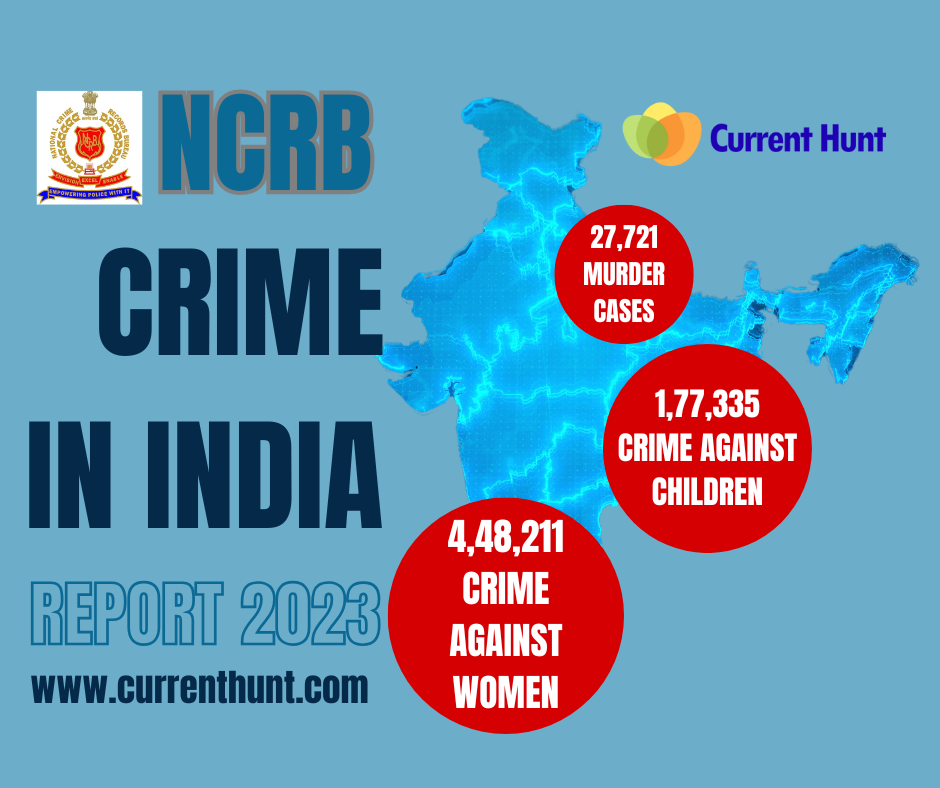Introduction
The National Crime Records Bureau (NCRB) has released the Crime in India 2023 Report, the most comprehensive compilation of nationwide crime statistics. The report provides crucial insights into the country’s changing crime patterns — from traditional offences like murder and assault to rising challenges such as cybercrimes and crimes against vulnerable groups. For Competitive Examinations Aspirants, this report is a valuable source to understand how data informs crime prevention and policy planning across India.
Overall Crime Trends in India (2023)
The year 2023 recorded a mixed pattern in India’s crime landscape — while certain serious crimes declined, the overall crime rate showed a slight rise.
- Total Murder Cases: Declined by 2.8%, from 28,552 in 2022 to 27,721 in 2023.
- Overall Crime Rate: Increased from 422.2 to 448.3 per lakh population.
- Motor Vehicle Act Violations: Nearly doubled, rising from 94,450 to 1.92 lakh cases.
- Crimes Against the Human Body: Increased by 2.3%, reaching 11.85 lakh cases.
These trends highlight that while grave crimes like homicide have slightly reduced, offences relating to public safety and bodily harm continue to demand greater enforcement attention.
Crimes Against Children: A Growing Concern
Crimes involving children showed a worrying rise in 2023.
- Total Cases: 1,77,335, marking a 9.2% increase over 2022 (1,62,449).
- Crime Rate: Increased to 39.9 per one lakh child population from 36.6 in the previous year.
- Major Offences:
- Kidnapping and Abduction: 79,884 cases (45% of total).
- POCSO Act Violations: 67,694 cases (38.2%).
State-wise Data:
- Madhya Pradesh: 22,393 cases (rate: 77.9)
- Maharashtra: 22,390 cases (rate: 62)
- Uttar Pradesh: 18,852 cases (rate: 22.1)
This steady rise underscores the need for stronger child protection frameworks, faster investigations under the POCSO Act, and enhanced community awareness.
Crimes Against Scheduled Tribes (STs)
Crimes against Scheduled Tribes saw a sharp escalation of 28.8%, registering 12,960 cases in 2023 compared to 10,064 in 2022.
Top States:
- Manipur: 3,399 cases
- Madhya Pradesh: 2,858 cases
- Rajasthan: 2,453 cases
The crime rate against STs stood at 12.4 per lakh population, showing that social and cultural vulnerabilities continue to influence crime trends.
Crimes Against Scheduled Castes (SCs)
Crimes against SCs recorded a slight increase of 0.4%, with 57,789 cases in 2023, compared to 57,582 in 2022.
Highest Reporting States:
- Uttar Pradesh: 15,130 cases
- Rajasthan: 8,449 cases
- Madhya Pradesh: 8,232 cases
- Bihar: 7,064 cases
The crime rate for SCs was 28.7 per lakh population, reflecting persistent issues of caste-based discrimination and violence in several parts of the country.
Cybercrime: A Rapidly Rising Threat
The digital age has brought with it an alarming rise in cyber-related offences.
- Total Cybercrime Cases: Increased by 31.2%, reaching 86,420 in 2023 (from 65,893 in 2022).
- Primary Motive: Online fraud, which accounted for 68.9% of cases (59,526 incidents).
Other Cyber Offences:
- Sexual Exploitation: 4,199 cases (4.9%)
- Extortion: 3,326 cases (3.8%)
- Cybercrime Rate: Increased from 4.8 to 6.2 per lakh population.
These figures underline the urgent need for digital literacy, stronger cybersecurity frameworks, and faster prosecution of online offences.
Crimes Against Women: Incremental but Persistent Rise
Crimes against women rose marginally by 0.4%, with 4,48,211 cases recorded in 2023, compared to 4.45 lakh the previous year.
- National Crime Rate: 66.2 incidents per lakh female population.
- Top States: Uttar Pradesh: 66,381 cases, followed by Maharashtra, Rajasthan, West Bengal, and Madhya Pradesh.
- Major Offence Categories:
- Cruelty by Husband or Relatives: 29.8%
- Kidnapping & Abduction: 19.8%
- Assault to Outrage Modesty: 18.71%
- POCSO-related Offences: 14.8% A notable increase was observed in dowry-related crimes, which rose by 14% — from 13,479 cases in 2022 to 15,489 in 2023. Uttar Pradesh topped this list with 7,151 cases, followed by Bihar (3,665) and Karnataka (2,322). Despite legal safeguards under the Dowry Prohibition Act and Protection of Women from Domestic Violence Act, social reforms and public awareness remain key to reducing such crimes.
About the National Crime Records Bureau (NCRB)
The National Crime Records Bureau (NCRB) was established in 1986 under the Union Ministry of Home Affairs. It functions as the country’s central data repository for all crime-related statistics.
Key Functions of NCRB:
- Data Compilation & Analysis: Collects, compiles, and publishes national crime statistics.
- Information Sharing: Coordinates and exchanges criminal data among states and international agencies.
- Fingerprint Database: Acts as a national warehouse for fingerprints of Indian and foreign criminals.
- Criminal Identification Support: Assists in locating inter-state and international offenders using biometric data. The NCRB’s Crime in India report remains one of the most authentic and data-driven tools for understanding India’s crime patterns.
Conclusion
The Crime in India 2023 Report paints a complex picture — progress in some areas, yet alarming trends in others. While murders and violent crimes have shown a decline, the steep rise in cybercrimes and offences against children highlights emerging threats in a changing society. For policymakers, educators, and law students, the report serves as a mirror reflecting the challenges of law enforcement, social awareness, and the evolving face of crime in modern India.
